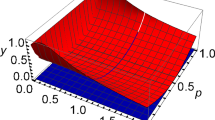Abstract
In this paper, an S-mixing entropy of quantum channels is introduced as a generalization of Ohya’s S-mixing entropy. We investigate several properties of the introduced entropy. Moreover, certain relations between the S-mixing entropy and the existing map and output entropies of quantum channels are investigated as well. These relations allowed us to find certain connections between separable states and the introduced entropy. Hence, there is a sufficient condition to detect entangled states. Moreover, several properties of the introduced entropy are investigated. Besides, entropies of qubit and phase-damping channels are calculated.
Similar content being viewed by others
References
Aldoshin, S.M., Feldman, E.B., Yurishchev, M.A.: Quantum entanglement and quantum discord in magnetoactive materials. Low Temp. Phys. 40, 3–16 (2014)
Amosov, G.G.: On estimating the output entropy of the tensor product of a phase-damping channel and an arbitrary channel. Probl. Inf. Trans. 49, 224–231 (2013)
Amosov, G.G.: Estimating the output entropy of a tensor product of two quantum channels. Theor. Math. Phys. 182, 397–406 (2015)
Araki, H., Lieb, E.H.: Entropy inequalities. Commun. Math. Phys. 18, 160–170 (1970)
Araki, H.: Relative entropy for states of von neumann algebras II. Publ. R.I.M.S. 11, 809 (1976)
Araki, H.: Relative entropy for states of von neumann algebras II. Publ. R.I.M.S. 13, 173–192 (1977)
Arveson, W.B.: Subalgebras of C *-algebras. Acta Math. 123, 141–224 (1969)
Bengstoon, I., Zyczkowski, K.: Geometry of Quantum States: An Introduction to Quantum Entanglment. Cambridge University Press, Cambridge (2006)
Bratteli, O., Robinson, D.: Operator Algebras and Quantum Statistical Mechanics I. Springer, Berlin (1979)
Choi, M.-D.: Completely positive linear maps on complex matrice. Linear Algebra Appl. 10, 285–290 (1975)
Holevo, A.S.: Quantum Systems, Channels, Information. De Gruyter, Berlin (2012)
Holevo, A.S.: Complementary channels and the additivity problem. Theory Probab. Appl. 51, 92–100 (2007)
Horodecki, R., Horodecki, P., Horodecki, M.: Quantum \(\alpha \)-entropy inequalities: Independent condition for local realism? Phys. Lett. A 210, 377–381 (1996)
Ingarden, R.S., Kossakowski, A., Ohya, M.: Information Dynamics and Open Systems. Kluwer, Dordrecht (1997)
Jamioalkowski, A.: Linear transformations which preserve trace and positive semidefiniteness of operators. Rep. Math. Phys. 3, 275–278 (1972)
Kossakowski, A., Ohya, M., Watanabe, N.: Quantum dynamical entropy for completely positive map. Infite Dimens. Anal. Quantum Probab. Relat. Top. 2, 267–282 (1999)
Muraki, N., Ohya, M.: Entropy functionals of Kolmogorov–Sinai type and their limit theorems. Lett. Math. Phys. 36, 327–335 (1996)
Muraki, N., Ohya, M., Petz, D.: Entropies of general quantum states. Open Syst. Inf. Dyn. 1, 43–56 (1992)
Nielsen, M.A., Chuang, I.L.: Quantum Computation and Quantum Information. Cambridge University Press, Cambridge (2000)
Nielsen, M.A., Kempe, J.: Separable states are more disordered globally than locally. Phys. Rev. Lett. 86, 5184 (2001)
Ohya, M.: On compound state and mutual information in quantum information theory. IEEE Trans. Inf. Theory 29, 770–774 (1983)
Ohya, M.: Note on quantum probability. L. Nuovo Cimento 38, 402–404 (1983)
Ohya, M.: Entropy transmission in C*-dynamical systems. J. Math. Anal. Appl. 100, 222–235 (1984)
Ohya, M.: Some aspects of quantum information theory and their applications to irreversible processes. Rep. Math. Phys. 27, 19–47 (1989)
Ohya, M., Petz, D.: Quantum Entropy and Its Use. Springer, Berlin (1993)
Ohya, M., Petz, D., Watanabe, N.: On capacities of quantum channels. Probab. Math. Stat. 17, 179–196 (1997)
Ohya, M., Watanabe, N.: Quantum entropy and its applications to quantum communication and statistical physics. Entropy 12, 1194–1245 (2010)
Rastegin, A.E.: On unified-entropy characterization of quantum channels. J. Phys. A Math. Theor. 45, 045302 (2012)
Roga, W., Puchala, Z., Rudnicki, L., Zyczkowski, K.: Entropic trade-off relation for quantum operations. Phys. Rev. A 87, 032308 (2013)
Roga, W., Zyczkowski, K., Fannes, M.: Entropic characterization of quantum operations. Int. J. Quantum Inf. 9, 1031–1045 (2011)
Ruskai, M.B., Szarek, S., Werner, E.: An analysis of completely positive trace-preserving maps on \(M_2\). Linear Algebra Appl. 347, 159–187 (2002)
Shannon, C.E.: A mathematical theory of communication. Bell Syst. Tech. J. 27, 623–656 (1948)
Stormer, E.: Positive Linear Maps of Operator Algebras. Springer, Berlin (2013)
Umegaki, H.: Conditional expectation in an operator algebra, IV. Kodai Math. Semin. Rep. 14, 59–85 (1962)
von Neumann, J.: Die Mathematischen Grundlagen der Quantenmechanik. Springer, Berlin (1932)
Watanabe, N.: Some aspects of complexities for quantum processes. Open Syst. Inf. Dyn. 16, 293–304 (2009)
Watanabe, N.: Quantum transmission processes and their entropies. Russ. J. Math. Phys. 21, 408–420 (2014)
Ziman, M.: Incomplete quantum process tomography and principle of maximal entropy. Phys. Rev. A 78, 032118 (2008)
Zyczkowski, K., Bengtsson, I.: On duality between quantum maps and quantum states. Open Syst. Inf. Dyn. 11, 3–42 (2004)
Acknowledgements
The authors would like to thank anonymous referees for their useful suggestions which allowed us to improve the content of the paper.
Author information
Authors and Affiliations
Corresponding author
Rights and permissions
About this article
Cite this article
Mukhamedov, F., Watanabe, N. On S-mixing entropy of quantum channels. Quantum Inf Process 17, 148 (2018). https://doi.org/10.1007/s11128-018-1916-8
Received:
Accepted:
Published:
DOI: https://doi.org/10.1007/s11128-018-1916-8




